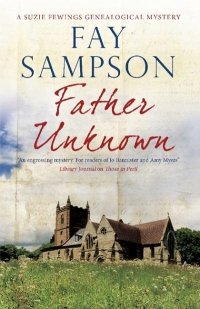 Written by Fay Sampson – Genealogy is something that has enjoyed booming popularity lately thanks to programmes like Who Do You Think You Are? and widespread access to websites full of the kind of records you need to trace your family tree. With skeletons being found in cupboards and family secrets coming to light, it shouldn’t come as a surprise to find that genealogy has also become a sub-genre within crime fiction.
Written by Fay Sampson – Genealogy is something that has enjoyed booming popularity lately thanks to programmes like Who Do You Think You Are? and widespread access to websites full of the kind of records you need to trace your family tree. With skeletons being found in cupboards and family secrets coming to light, it shouldn’t come as a surprise to find that genealogy has also become a sub-genre within crime fiction.
Father Unknown is actually the fourth book in the Suzie Fewings series. Suzie is a keen amateur family historian who likes nothing better than to immerse herself in the documents at her local record office in order to build up a picture of her own ancestry. However, as this story opens, a chance meeting with American tourist Prudence Clayton sets her off on two investigations that bear some striking similarities.
Prudence is something of a newbie when it comes to genealogy and has come to England hoping to find a glittering heritage. She’s in for a shock, finding the words ‘base child’ emblazoned on her several times great grandfather’s birth certificate. When Suzie enlightens her as to its meaning, she is more than a little upset and so begins the first mystery.
Mystery number two comes when Suzie returns home to find the remains of a pregnancy testing kit in the bin. Concerned that her teenage daughter may be pregnant, she tries to get to the bottom of things, but finds that the truth is far from simple. This leads her and her family into a situation far more deadly than they could ever have envisioned. She discovers that it is another teen who is pregnant and this girl has subsequently disappeared. There’s a search for the missing girl, flaring tempers, and acts of domestic violence. How much danger is this girl in and, more importantly, who is the father of her unborn child? The truth when it comes out isn’t likely to be pretty.
The two central themes of this book are rape and the subsequent pregnancy of the victim. Sampson deals with these subjects with a great deal of sensitivity, but the parallel in the individual stories of two teenage girls, separated by time, is the point the author is really highlighting here. Although it can still be a thorny area, it is something that is dealt with much more compassionately today than back in the 18th century. Both girls are victims, but essentially, a girl who was taken advantage of in days long past was likely to be treated more harshly than a teenager in the same position now.
Sampson pulls no punches. She doesn’t sugar-coat the facts to make them more palatable, but she does leave you with a ray of hope that even the worst situation can come good in the long run.
Severn House
Print/Kindle
£7.27
CFL rating: 4 Stars







